Although using watercolor paints has always been popular in arts and crafts, more and more people have started to integrate watercolor pencils into their artwork. With so many people being new to using them, we have noticed a number of requests for watercolor pencil ideas for beginners to help improve their artwork. Thankfully, here are some quick and easy things that you are able to practise and implement when using watercolor pencils that can drastically improve the end result of your art.
Before we go any further, we just want to quickly say that all of these ideas can be done with a decent, cheap set of watercolor pencils as well as the intermediate and premium options on the market. As this article is predominantly targeted towards beginners to using watercolor pencils, we wanted to ensure that everything that we suggested would work with an entry-level pencil set.
In addition to that, just like most things related to arts and crafts, practise makes perfect. Although these ideas have been selected due to being quick, easy, and simply to try, the more you practise them the better you will get and the better your artwork will end up looking. If you do have the time available, we would recommend that you try to implement as many of the ideas below in your watercolor pencil artwork as often as possible to see fast improvement.
Watercolor Pencil Ideas For Beginners
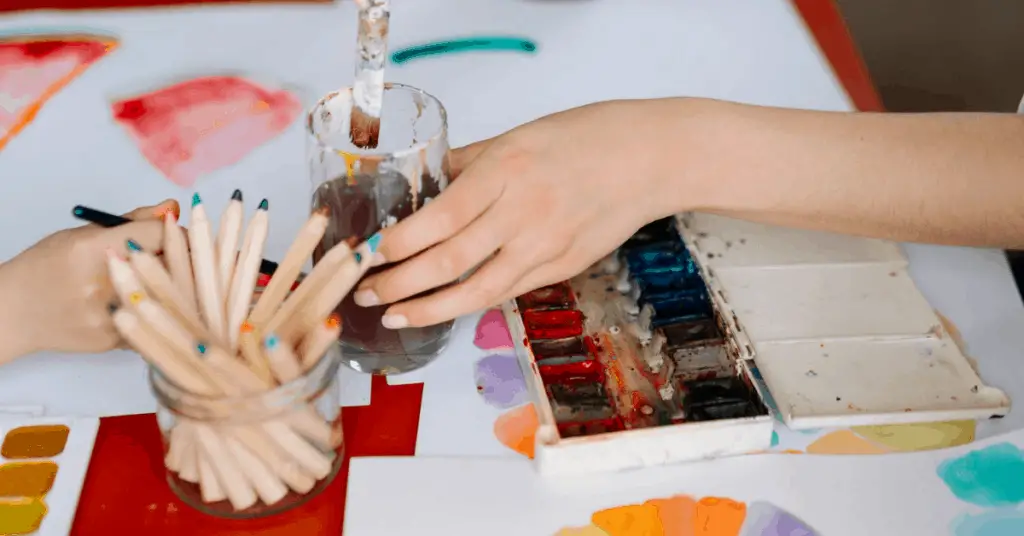
Although we have settled on five ideas that you are able to use to great effect, there are a huge number of tips and tricks that you can take advantage of with watercolor pencils to get better results. We have settled on these five as they are quick and easy to implement making them very beginner friendly for our readers. As you become more and more experienced with using your watercolor pencils you will be able to try out more and more techniques in the intermediate level that we will cover in a future article.
Develop Your Brush Technique
So many people who are new to using watercolor pencils overlook the brush potential with some people not actually integrating brushwork at all. Just because you have access to a pencil, does not mean that you should neglect your brushwork and even a cheap brush set is able to improve the results that you are able to get.
There are three main ways that you are able to integrate the use of a brush with your watercolor pencils when you are first starting out. As you gain more experience you are able to add additional brush based techniques but for the time being, we would recommend that you stick to the following three.
The first is quick and easy and it is based around you drawing the background of your image with your pencils and then going over it with a wet brush to blend it all together. If you are using an entry-level watercolor pencil set then you may have to go over your background two or even three times to get rid of the pencil lines and smooth everything out but it is definitely worth it.
A simple trick that you can use to take this first brush effect to the next level is to use multiple colors for the background of your image as shown in the image below. Once you run your wet brush over the pencil on your paper it will all blend together and smooth everything out too bring the background together. Depending on what you are planning for your artwork, you may only need to use two or three colors for this effect but you can use more if needed.
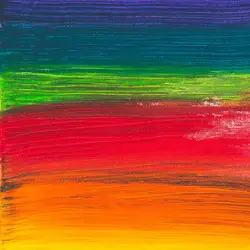
Although this next brushwork tip is a little more niche and depends on what you are actually trying to do with your specific piece of artwork, you can run the bristles of your brush over the nib of your watercolor pencil and then apply it directly to your paper or canvas. If you are working on a large piece of art then this can end up saving you a large amount of time when compared to going over everything with your pencils and then running over that with your brush.
Although you will have to keep on running the bristles of your brush over the nib of your pencils, you should easily be able to get a nice and consistent pigment transfer when running your brush over your paper or canvas. Just keep in mind that the larger your brush, the more you will have to run it against the nib of your pencil prior to applying it to your paper.
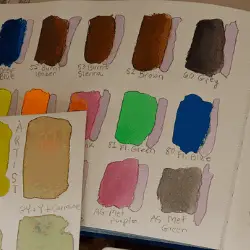
The third and final brushwork hack that you are able to use with your watercolor pencils is to make your own little palette similar to the image above. Simply take each of the watercolor pencil colors that you are planning to use in this particular piece of artwork and scribble a little onto some spare paper. You then apply your brush directly to the specific area for each color as and when you need it to quickly get the pigment onto your brush.
If you are working on a large piece of art that will need a large amount of brushwork then this is a great technique that you can take advantage of. Although it does take a little more time when actually making your palette by scribbling on some spare paper with your pencils, in the long run it ends up saving you a surprising amount of time.
Integrate Some Tape
Another quick and easy win that you are able to use to help improve the end result of your watercolor pencil artwork is to make your own tape boarders while applying your pencils to the paper or any other surface. Although some people do insist on using artists tape for this, if you are a beginner and new to using watercolor pencils, sticking to masking tape will offer a similar effect while also keeping your costs down.
You simply apply some of the tape around the edges of your paper to add a straight edged boarder so you can go over the edges when applying your watercolor pencils to your paper. Once your artwork is complete, you simple remove the tape that inturn removes all of the over the edge strokes leaving you with a nice and smooth boarder line keeping your artwork neat and tidy.
Depending on what you are wanting to do, you can take this a step further and put multiple areas on the paper all sectioned off with their own tape for your artwork to keep everything looking neat and tidy when complete. This simple trick has become a very popular hack for making neat and tidy bullet journal spread pages using watercolor pencils too with many people taking advantage of it.
Practise Your Backgrounds
Although this next tip may sound like an obvious one, we see so many people only ever sticking to one technique for the backgrounds of their watercolor pencil art. This is a huge mistake as it restricts what you are actually able to do with your pencils and restricts the versatility that you are able to get out of them. Even if you just play around with the three different brushwork techniques that we covered earlier in the article you can change things up and get a different look to your different pieces.
As a beginner, you should really be experimenting as much as possible, especially with your backgrounds to develop your own style. Depending on how serious you want to take your watercolor pencil art, you may want to spend a few sessions just making backgrounds over and over again playing around with different ideas and concepts to see how they turn out too. Watercolor pencils offer a ton of versatility considering how cheap they are as well as their ease of use so you should try to use this to your advantage.
Mix In Some Gouache
Although some people may class this as more of an intermediate technique as you are required to mix mediums and have some gouache paint in your collection, we feel that it is easy enough for beginners to start using early on and it offers a great effect. Although there are a wide range of ways that you are able to use this effect as well as using other paint mediums too, one of the main effects that this is used on is for night skys.
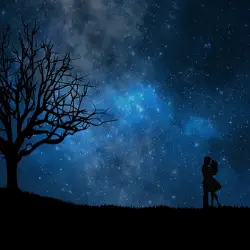
The artwork above shows how the artist has built out the night sky, then build out the stars, and finally added the silhouette foreground images with some excellent use of layering. You are able to achieve a similar effect with your artwork when using your watercolor pencils if you pick up some white gouache to use for the starts helping to add that little detail that goes a long way to bring the image together.
You simply use any of the brush techniques covered earlier in the article to build out your background with blues and blacks and then leave your watercolor pencils to dry. Thankfully, they tend to dry considerably faster than watercolor paints making the process much quicker but once your pencils have dried you then add small spots of your white gouache to the background for the stars.
Although this can take a little practise to get used to, it really does add that additional layer to your artwork to help improve the end result. If possible, we would recommend that you take some time out to only work on building out backgrounds and then adding gouache for different effects before trying it on a serious piece of artwork to ensure you can get the effect right.
Focus On Detailed Foregrounds
So many beginners to watercolor pencils seem to overlook that hybrid nature of their tools and only focus on the pencil side but you can mix the brushwork techniques that we explained earlier in the article with direct pencil application in the foreground for some excellent results. The basic idea is that you blanket your backgrounds with a brush effect to blend it altogether nicely and then leave it to dry before going over the foreground with just your pencils.
Provided you ensure that the nibs of your watercolor pencils are sharp with a decent point on them prior to using them, this allows you to get some excellent levels of detail in your foreground with ease. The contrast of the blended brush effect for the background and the high detail foreground can go very well together and is an important skill for beginners to master before moving onto more intermediate-level techniques.
Play With The Color Wheel
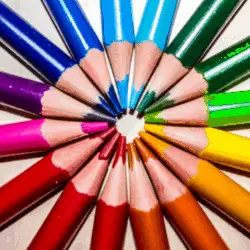
If you are a total beginner to using your watercolor pencils then you may not be familiar with the color wheel and the various ways that you are able to use it to enhance the color combinations in your artwork. There are a number of different ways that you are able to use its various rules to get different effects from your watercolor pencil collection with it being a whole other article in itself.
Setting some time aside to read up on the various ways that you are able to use the color wheel and its various rules to your advantage is well worth it for a beginner in our opinion. It can offer you some quick and easy hacks for complimentary colors, clashing colors, and a number of other things for you to take advantage of in your artwork.
Conclusion
That brings our article going over six watercolor pencil ideas for beginners to a close. Even if you only start to integrate a few of these tips and tricks into your watercolor pencil art you should start to see rapid improvements in artwork once completed. As with most things in the arts and crafts space, much of your artwork that you can do is only limited by your imagination so we always recommend that you practise and experiment with the tips and tricks as much as possible to ensure that you are getting the most out of them.